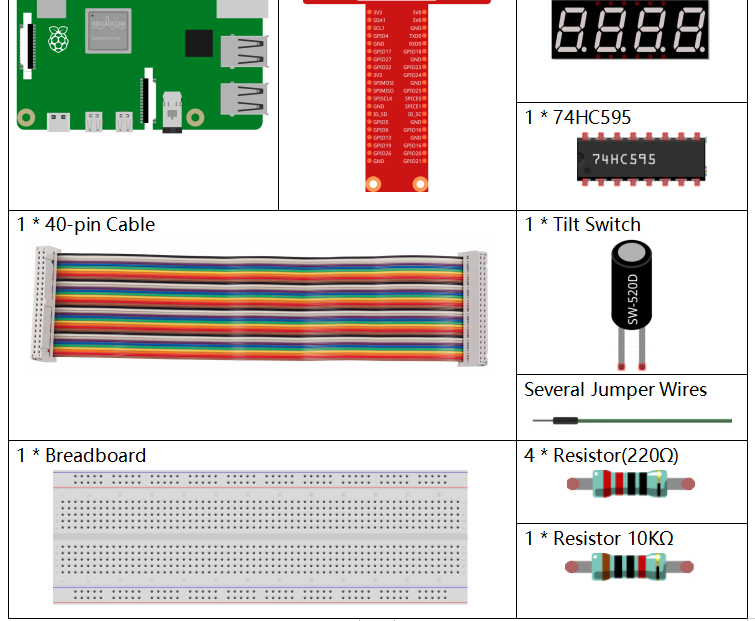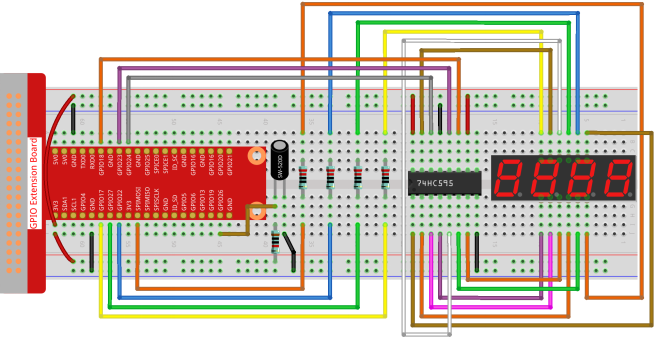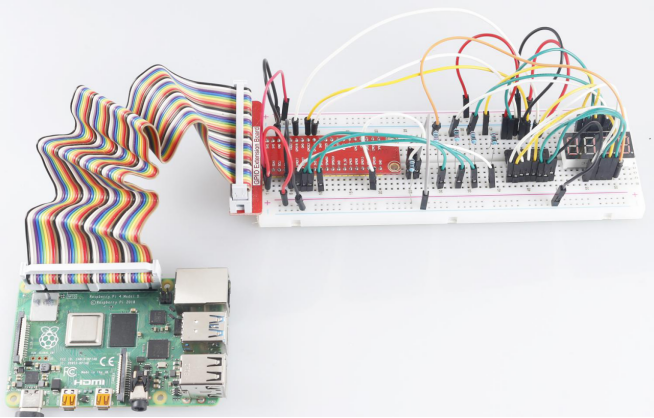Introduction
Next, follow me to make a game device to challenge your concentration. Tie the tilt switch to a stick to make a magic wand. Shake the wand, the 4-digit segment display will start counting, shake again will let it stop counting. If you succeed in keeping the displayed count at 10.00, then you win. You can play the game with your friends to see who is the time wizard.
Components

Schematic Diagram
| T-Board Name | physical | wiringPi | BCM |
| GPIO17 | Pin 11 | 0 | 17 |
| GPIO27 | Pin 13 | 2 | 27 |
| GPIO22 | Pin 15 | 3 | 22 |
| SPIMOSI | Pin 19 | 12 | 10 |
| GPIO18 | Pin 12 | 1 | 18 |
| GPIO23 | Pin 16 | 4 | 23 |
| GPIO24 | Pin 18 | 5 | 24 |
| GPIO26 | Pin 37 | 25 | 26 |

Experimental Procedures
Step 1: Build the circuit.

- For C Language Users
Step 2: Go to the folder of the code.
cd /home/pi/davinci-kit-for-raspberry-pi/c/3.1.13/
Step 3: Compile the code.
gcc 3.1.13_GAME_10Second.c –lwiringPi
Step 4: Run the executable file.
sudo ./a.out
Shake the wand, the 4-digit segment display will start counting, shake again will let it stop counting. If you succeed in keeping the displayed count at 10.00, then you win. Shake it one more time to start the next round of the game.
Code Explanation
void stateChange(){
if (gameState == 0){
counter = 0;
delay(1000);
ualarm(10000,10000);
}else{
alarm(0);
delay(1000);
}
gameState = (gameState + 1)%2;
}
The game is divided into two modes:
gameState=0 is the “start” mode, in which the time is timed and displayed on the segment display, and the tilting switch is shaken to enter the “show” mode.
GameState =1 is the “show” mode, which stops the timing and displays the time on the segment display. Shaking the tilt switch again will reset the timer and restart the game.
void loop(){
int currentState =0;
int lastState=0;
while(1){
display();
currentState=digitalRead(sensorPin);
if((currentState==0)&&(lastState==1)){
stateChange();
}
lastState=currentState;
}
}
GameState =1 is the “show” mode, which stops the timing and displays the time on the segment display. Shaking the tilt switch again will reset the timer and restart the game.
Loop() is the main function. First, the time is displayed on the 4-bit segment display and the value of the tilt switch is read. If the state of the tilt switch has changed, stateChange() is called.
- For Python Language Users
Step 2: Go to the folder of the code.
cd /home/pi/davinci-kit-for-raspberry-pi/python/
Step 3: Run the executable file.
sudo python3 3.1.13_GAME_10Second.py
Shake the wand, the 4-digit segment display will start counting, shake again will let it stop counting. If you succeed in keeping the displayed count at 10.00, then you win. Shake it one more time to start the next round of the game.
Code Explanation
def stateChange():
global gameState
global counter
global timer1
if gameState == 0:
counter = 0
time.sleep(1)
timer()
elif gameState ==1:
timer1.cancel()
time.sleep(1)
gameState = (gameState+1)%2
The game is divided into two modes:
gameState=0 is the “start” mode, in which the time is timed and displayed on the segment display, and the tilting switch is shaken to enter the “show” mode.
GameState =1 is the “show” mode, which stops the timing and displays the time on the segment display. Shaking the tilt switch again will reset the timer and restart the game.
def loop():
global counter
currentState = 0
lastState = 0
while True:
display()
currentState=GPIO.input(sensorPin)
if (currentState == 0) and (lastState == 1):
stateChange()
lastState=currentState
Loop() is the main function. First, the time is displayed on the 4-bit segment display and the value of the tilt switch is read. If the state of the tilt switch has changed, stateChange() is called.
def timer():
global counter
global timer1
timer1 = threading.Timer(0.01, timer)
timer1.start()
counter += 1
After the interval reaches 0.01s, the timer function is called; add 1 to counter, and the timer is used again to execute itself repeatedly every 0.01s.
Phenomenon Picture

